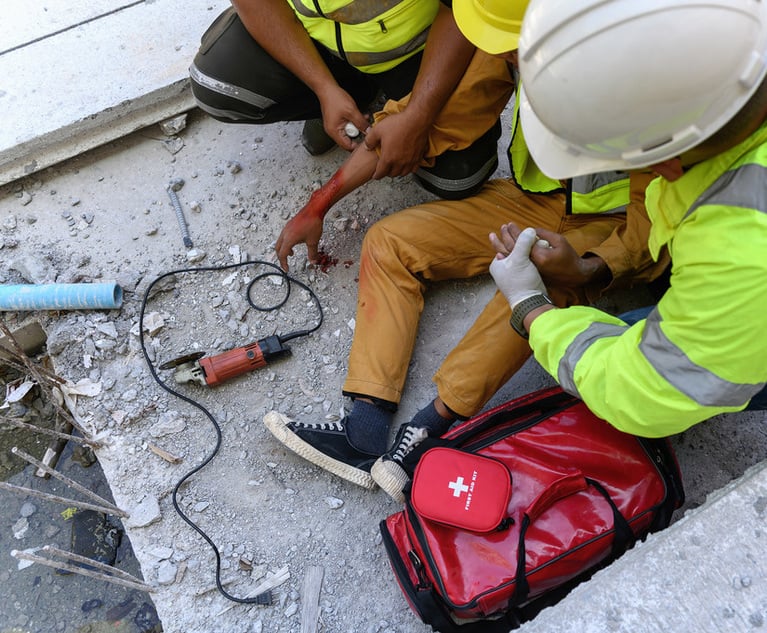Does a Roof's Warranty Remain Effective Under Solar Panels?
The advantages of solar power installation should be weighed against the preservation of the structural integrity and the useful life of the rooftop structures themselves. In particular, property owners should ensure that the warranty covering the roof itself remains effective.
April 19, 2019 at 08:00 AM
7 minute read
 Credit: Diyana Dimitrova/Shutterstock.com
Credit: Diyana Dimitrova/Shutterstock.com
As commercial and residential property owners respond to the demands for clean energy motivated by carbon emissions concerns and the budgetary prerogatives of energy cost and governmental enactments creating financial incentives, solar installations are becoming more common both nationally and in New Jersey. As of 2018, despite its relatively small land area, New Jersey ranked sixth among the states in total installed solar capacity (https://www.seia.org/solar-industry-research-data), and has seen a dramatic increase in solar coverage over the last 10 years.
Solar panels and related infrastructure are often constructed as rooftop-mounted facilities, particularly in the northern, and more densely populated and built-up half of the state. The advantages of solar power installation should, however, be weighed against the preservation of the structural integrity and the useful life of the rooftop structures themselves. In particular, property owners should ensure that the warranty covering the roof itself remains effective in the context of the additional roof penetrations, weight, and wind loads the installation and continued presence of solar panels create. Legal practitioners should be mindful of the concerns of warranty coverage or preservation in the draft of solar power purchase agreements (PPA) and engineering, procurement and construction (EPC) agreements.
At the outset, it is important to distinguish two essential types of conditions or issues with respect to solar roof installations with different implications for warranty and liability issues. The first goes to the fundamental warrantability or insurability of the roof following the installation work, while the second involves whether and to what extent a warranty will cover the condition of the roof based on events subsequent to installation.
First, one of the primary issues arising in the placement of solar infrastructure on rooftops relates to the penetrations of the roof itself in connection with physical attachment or racking to support solar panels. In the case of Miller v. Icon Solar Power, a homeowner suffered significant and relatively predictable water damage caused by improperly sealed roof penetrations. (2015 WL 1514666 (Ohio Com.Pl.) (Trial Pleading)). Similarly, in complex litigation involving several insurance providers, plaintiffs alleged that a specialized coating installed specifically in advance of solar installation failed to preserve the integrity of the roofing of a commercial warehouse facility from water intrusion. (Westchester Surplus Lines Ins. Co. v. Arch Specialty Ins. Co. (2018 WL 6186601 (S.D.N.Y.)(Trial Motion, Memorandum and Affidavit)). These examples involve defects resulting from conditions arising at the time of the initial solar installation, and therefore relate to the willingness of a commercial roof warrantor to guaranty. Discussed below are best practices for drafting of solar installation agreements in regard to such concerns.
In contrast, problems that may arise from the placement of solar infrastructure, its weight or wind load properties, implicate the terms and conditions of any rooftop warranty and, as detailed below, relate to best practices in terms of the effectiveness and preservation of that warranty. The first consideration is the weight of the panels, an issue that may impact the structural integrity of the roof. Conventional solar panels may weigh approximately three to four pounds per square foot. In commercial settings, however, the load on the roof will likely include additional weight for racking that will provide support and appropriate angle for the solar panels. (https://www.atlasroofing.com/news/article/warranties-needed-for-rooftop-solar-panelson). These burdens would need to be evaluated in terms of the condition of the roof. In addition, the placement of solar panels and racking in the commercial (i.e., flat roof) setting may create wind hazards not otherwise present. For example, one case relating to Superstorm Sandy focused in part on claims that seven panels, each measuring three by nine feet, had blown off the roof of a New York City residential building during the storm, leading to both the loss of the panels and damage to the affected area of the roof. (Printing House Condominium Association v. Fireman's Fund Ins. Co., 2017 WL 46395150 (N.Y. Sup.)). Issues relating to either weight or wind load of solar panels are then likely to arise subsequent to the period of installation and therefore relate to which matters might ultimately be agreed to be covered by any solar warranty.
Conventional roof warranties would typically be expected to exclude from coverage both installation-phase conditions and damage, or claims arising during the useful life of the roof that may relate to additional weight or wind load in connection with solar panel installation. GAF, as the largest commercial roofing manufacturer in the United States, offers warranty documentation that is both typical and instructive. Standard warranties include exceptions for “improper workmanship in applying … any other roof component,” where any defect resulting from roof penetrations or otherwise in installing solar infrastructure would not be covered under warranty. (https://www.gaf.com/en-us/for-professionals/resources/commercial-warranty-information). In addition, commercial warranties frequently include exceptions from coverage for matters resulting from “changes in the use of the building, or any repairs, modifications or additions to the GAF roofing materials after the roof is completed.” Without more, then, conventional roof warranties are generally drafted to exclude the kind of extra load or wind hazard created by the installation of solar panels.
However, the largest roofing manufacturers in the United States have made some progress down the road of resolving the imperatives of increased solar coverage using rooftop installations, and the need for security in the financing and integrity of roofing work. GAF, for example, offers a commercial solar roofing program that combines the installation of new roofing with solar facilities. Under this program, additional coverage for both installation defects and long-term wind damage is included. In addition, the company offers a DecoTech Solar Roofing System in the residential setting with an included warranty. Note that, even under this warranty, while manufacturing defects generally are covered for a 25-year period, “blow off/wind damage” conditions are covered for only a 10-year period. “GAF warrants to you that your DecoTech™ Solar Module(s) will not blow off, or sustain damage from winds, including gusts, up to 110 mph / 175 km/h due to a manufacturing defect.” Note that, although acknowledging the potential severity of wind-caused roof damage this warranty relates only the panels themselves, and “[c]osts related to underlayment, metal work, and flashings are not included.”
When drafting solar agreements on behalf of property owners that include a roof-installation component, practitioners should use care to insure that appropriate roof warranties are delivered or preserved, as appropriate. While more than one warranty may ultimately be in effect—there may be separate coverage for roofing materials and roofing workmanship—diligent representation should include an evaluation of the financial resources backing up any roofing guarantee, and it may therefore be best to take measures to preserve the warranty offered by an established roofing supplier. Solar agreements should stipulate the exact mechanism by which the panels and racking will be attached to the roof and any padding necessary to insulate the roof surface from the solar infrastructure. Absent a comprehensive roof-solar package like the GAF products discussed, agreements may need to contemplate the interaction of multiple separate warranties for roofing, the solar equipment itself, and for workmanship. In such event, careful drafting should specify where one warranty ends and another begins. For example, for residential construction, the State of Hawaii has enacted legislation requiring the solar contractor to provide coverage for labor and workmanship in effect to fill any gaps in the coverage of the otherwise applicable roof warranty. (Hawaii Revised Statutes §196-7).
As noted, solar installation in New Jersey is extensive and promises to continue to grow. Under New Jersey's solar renewable energy credit (SREC) system, most property owners can realize substantial operational savings by installing solar generation facilities. Because these systems will frequently be installed on rooftops, implicating significant cost concerns in workmanship and the long-term viability of roof structures, practitioners should exercise care in maximizing warranty coverage.
Jonathan B. King is counsel with Porzio, Bromberg & Newman, in Morristown, and a member of the firm's Real Estate and Corporate, Commercial and Business Law Practice Groups.
This content has been archived. It is available through our partners, LexisNexis® and Bloomberg Law.
To view this content, please continue to their sites.
Not a Lexis Subscriber?
Subscribe Now
Not a Bloomberg Law Subscriber?
Subscribe Now
NOT FOR REPRINT
© 2025 ALM Global, LLC, All Rights Reserved. Request academic re-use from www.copyright.com. All other uses, submit a request to [email protected]. For more information visit Asset & Logo Licensing.
You Might Like
View All

Dispute Resolution Boards—Getting Real Time Decisions on Construction Projects
7 minute read
Insurer Has No Duty to Defend 'Laidlow' Claims, NJ Supreme Court Says
3 minute read
Construction Worker Hit by Falling Concrete Settles Claims for $2.3M
4 minute readTrending Stories
- 1No Two Wildfires Alike: Lawyers Take Different Legal Strategies in California
- 2Poop-Themed Dog Toy OK as Parody, but Still Tarnished Jack Daniel’s Brand, Court Says
- 3Meet the New President of NY's Association of Trial Court Jurists
- 4Lawyers' Phones Are Ringing: What Should Employers Do If ICE Raids Their Business?
- 5Freshfields Hires Ex-SEC Corporate Finance Director in Silicon Valley
Who Got The Work
J. Brugh Lower of Gibbons has entered an appearance for industrial equipment supplier Devco Corporation in a pending trademark infringement lawsuit. The suit, accusing the defendant of selling knock-off Graco products, was filed Dec. 18 in New Jersey District Court by Rivkin Radler on behalf of Graco Inc. and Graco Minnesota. The case, assigned to U.S. District Judge Zahid N. Quraishi, is 3:24-cv-11294, Graco Inc. et al v. Devco Corporation.
Who Got The Work
Rebecca Maller-Stein and Kent A. Yalowitz of Arnold & Porter Kaye Scholer have entered their appearances for Hanaco Venture Capital and its executives, Lior Prosor and David Frankel, in a pending securities lawsuit. The action, filed on Dec. 24 in New York Southern District Court by Zell, Aron & Co. on behalf of Goldeneye Advisors, accuses the defendants of negligently and fraudulently managing the plaintiff's $1 million investment. The case, assigned to U.S. District Judge Vernon S. Broderick, is 1:24-cv-09918, Goldeneye Advisors, LLC v. Hanaco Venture Capital, Ltd. et al.
Who Got The Work
Attorneys from A&O Shearman has stepped in as defense counsel for Toronto-Dominion Bank and other defendants in a pending securities class action. The suit, filed Dec. 11 in New York Southern District Court by Bleichmar Fonti & Auld, accuses the defendants of concealing the bank's 'pervasive' deficiencies in regards to its compliance with the Bank Secrecy Act and the quality of its anti-money laundering controls. The case, assigned to U.S. District Judge Arun Subramanian, is 1:24-cv-09445, Gonzalez v. The Toronto-Dominion Bank et al.
Who Got The Work
Crown Castle International, a Pennsylvania company providing shared communications infrastructure, has turned to Luke D. Wolf of Gordon Rees Scully Mansukhani to fend off a pending breach-of-contract lawsuit. The court action, filed Nov. 25 in Michigan Eastern District Court by Hooper Hathaway PC on behalf of The Town Residences LLC, accuses Crown Castle of failing to transfer approximately $30,000 in utility payments from T-Mobile in breach of a roof-top lease and assignment agreement. The case, assigned to U.S. District Judge Susan K. Declercq, is 2:24-cv-13131, The Town Residences LLC v. T-Mobile US, Inc. et al.
Who Got The Work
Wilfred P. Coronato and Daniel M. Schwartz of McCarter & English have stepped in as defense counsel to Electrolux Home Products Inc. in a pending product liability lawsuit. The court action, filed Nov. 26 in New York Eastern District Court by Poulos Lopiccolo PC and Nagel Rice LLP on behalf of David Stern, alleges that the defendant's refrigerators’ drawers and shelving repeatedly break and fall apart within months after purchase. The case, assigned to U.S. District Judge Joan M. Azrack, is 2:24-cv-08204, Stern v. Electrolux Home Products, Inc.
Featured Firms
Law Offices of Gary Martin Hays & Associates, P.C.
(470) 294-1674
Law Offices of Mark E. Salomone
(857) 444-6468
Smith & Hassler
(713) 739-1250






